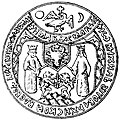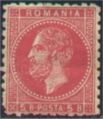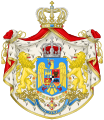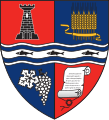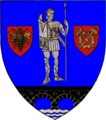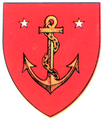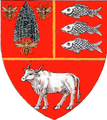"Istoria ieroglifică", ancient book by Prince Dimitrie Cantemir
-
Fierce battle scene of Dacians against Roman legions of Emperror Trajan, from Trajan's Column.
-
The tomb of Stephen the Great and his last wife, Maria Voichiţa, Putna Monastery. Prince Stephen the Great(known also as : Stephen III of Moldavia or Stephen III (c. 1432 – July 2, 1504)) was sanctified--or canonized-- as "Stephen the Great"--Ştefan cel Mare şi Sfânt-- "Stephen the Great and Holy" (canonized on July 12, 1992, in Bucharest, Romania, by the Romanian Orthodox Church).
-
Moldavia's coat of Arms in 1481 under the rule of Stephen the Great and Holy--Ştefan cel Mare şi Sfânt
-
Seal of Michael the Brave after the union of the three Principates of Walachia, Moldova and Transylvania in 1600 AD.
-
Moldavia, Transylvania and Wallachia under Michael the Brave's authority (1600)
-
Map of the principate of Moldova in Romania, drawn in the first Romanian book written in 1714 and printed in Latin "Description Modlaviae" by Prince Dimitrie Cantemir:"CAPUT XI - DE LEGIBUS MOLDAVIAE PROVINCIALIBUS. Quae antiquitus Daciae leges fuerint, scire prohibet historicorum iis de rebus silentium: voluntatem tamen principum, naturaeque iura legis scriptae vim et autoritatem habuisse coniicere licet, e simili reliquarum gentium barbararum consuetudine. Posteaquam vero ab Ulpio Traiano Imper. victo Decebalo ..." CHAPTER 11. ON THE LAWS OF THE PROVINCE OF MOLDAVIA":The province of Moldavia is part of the ancient teritory of Dacia conquered by the Roman Empire of Trajanus (Trajan) as shown on Trajan's column- Ulpio Traiano, and has inherited the ancient laws of Dacia and Rome.
-
The letter of Neacşu of Câmpulung in June 1512--the oldest surviving document in the Romanian language written with Cyrillic letters.
-
Commemorative Post stamp in Moldavia showing an early print of a Romanian Orthodox Bible displayed at Museum of Romanian Literature "Mihail Kogălniceanu" in Chișinău, Besarabia
-
The first Romanian proclamation of the Independent State and Kingdom of Romania in 1881
-
The first Romanian post stamp in Moldavia issued in 1847, representing the head of the "zimbru"-- a rare species of bison now extinct from the Carpathian forests that is also depicted on the Coat of Arms of ancient Romania's province of Moldavia; the writing at the top of the stamp with cyrillic letters reads: "Porto scrisori"--Letter stamp.
-
Romanian stamp of Prince Alexandru Ioan Cuza from 1863-1864
-
Romanian stamp of Prince Carol I of Romania in 1866
-
Roumanian post stamp issued in 1872, in Paris, France, for use in Roumania, portraying King Carol I; the stamp has the same layout and design as similar stamps issued with the portrait of Napoleon III- the Emperor of France at the time. Stamp face value was 5B, or 5 bani (0.05 Lei).
-
Coat of Arms of the first Kingdom of Romania ruled by King Carol I in 1881
-
The Unification of Bessarabaia and Romania Document in 1918--"Actul Unirii": ACTUL UNIRII VOTAT DE SFATUL ȚĂRII LA 27 MARTIE ST.V. 1918- ÎN NUMELE POPORULUI BASARABIEI SFATUL ȚĂRII DECLARĂ REPUBLICA DEMOCRATICĂ MOLDOVENEASCĂ (BASARABIA) ÎN HOTARELE EI DINTRE PRUT,NISTRU,DUNĂRE, MAREA NEAGRĂ ȘI VECHILE GRANIȚE CU AUSTRIA, RUPTĂ DE RUSIA ACUM O SUTĂ ȘI MAI BINE DE ANI DIN TRUPUL MOLDOVEI ÎN PUTEREA DREPTULUI ISTORIC ȘI DREPTULUI DE NEAM...DE AZI ÎNAINTE ȘI PENTRU TOTDEAUNA SE UNEȘTE CU MAMA SA ROMÂNIA. TRĂIASCĂ UNIREA BASARABIEI CU ROMÂNIA
-
Coat of Arms of the Kingdom of Romania (1921-1947)
-
Coat of Arms of Romania
-
Romanian Army flag in 1914 during WWI
-
Map of Dacia during king Burebista's reign of 60 to 44 BC.
-
Roman province of Dacia in 106 AD.
-
The Roman Empire at the time of death of Emperor Trajan in 117 AD.
-
The Greater Romania Map and Frontiers after WWI during the reign of King Ferdinand I of Romania
Gallery for Putna Monastery[edit]
-
Putna, Old Church
-
Putna, Old Church
-
Putna Monastery
-
Putna Monastery
-
Putna Monastery
-
Putna Monastery
-
Putna Monastery
Gallery: Images of important Romanian Kings, Rulers and Princes (Voievodes/Voievozi, Domnitori)[edit]
The following gallery presents authentic images of the most important rulers of Romania and its Principates from ancient (e.g., 82 BC) to modern times (1947 AD). These Romanian domnitori and kings are renowned for their major contributions to maintaining an independent Romania, or Romanian Principates, in spite of numerically superior foreign forces, be they Turkish-Ottoman, Russian, Mongolian, Polish or Hungarian.
-
Statue in Orashtie (Roum.-Orăștie) of ancient King Burebista--"(Ancient Greek: "Βοιρεβίστας") was a king of the Getae and Dacians, who unified for the first time their tribes and ruled them between 82 BC and 44 BC."
-
Two Romanian Post stamps from the year 1980 comemorating "2050" years from Burebista's ancient reign of "the first integrated Dacian State under the rule of Burebista".
-
Marble bust of Roman Emperor-Trajan - Marcus Ulpius Nerva Traianus (found at the Glyptothek, Munich), the conqueror of Dacia and the founder of the first Roman colony in Dacia in 106 AD; ruler of both the Roman Empire and Dacia between 106 and 117 AD (Emperor of Rome between 97 and 117 AD).
-
Fresco from the Church at Argesh (Roum.-Argeș) of Basarab I the Founder (Roum. "Basarab Întemeietorul"), the first Voievode or Ruler of Wallachia(c. 1310/1319–1352); he lent his name to the Romanian province of Bessarabia (Roum. -Basarabia--meaning "The Country of Basarab") re-occupied by the soviet armies in 1943.
-
Fresco depicting Stephen the Great, Prince of the Romanian province of Moldavia, from "The Book of the Four Gospels of Humor" printed in 1473.
-
Orthodox Saint Stephen the Great of Romania
-
Post-humous painting of Vlad III the Impaler (Roum. Vlad Ţepeş), or Vlad The Devil--Vlad Dracul, Prince of Wallachia (1456-1462; d. 1477)
-
Michael Valachiae Transalpinae Voivoda, Sacrae Caesareae Regiae Majestatis Consiliarius per Transylvaniam Locumtenens, cis transylvaniam partium eius super exercitu Generalis Capitaneus". ("Michael, Voivode of Wallachia, the councillor of His Majesty the Emperor and the King, his deputy in Transylvania and General Captain of his troops from Transylvania.")
-
Michael the Brave at Alba Iulia uniting under him in 1600 Transylvania with both Wallachia and Moldavia: Prince of Wallachia, Prince of Transylvania and Prince of Moldavia, May - September 1600.
-
Constantin Brâncoveanu (1654 – August 15, 1714) was Prince of Wallachia between 1688 and 1714.
-
Prince Dimitrie Cantemir, ruler of the province Moldavia of Romania, and Member of the Royal Academy of Berlin
-
Prince Dimitrie Cantemir's official portrait
-
Russian general Pavel Kiseleff (Pavel Kiselyov), appointed by the tzar of Russia to command the Russian occupying troops in Wallachia and Moldavia during the Russo–Turkish War of 1828–1829;"Prior to that, the Russian commander-in-chief, Prince Peter Wittgenstein, had moved into Wallachia and took Brăila and Bucharest without difficulty....Under his (Kisselef's) administration, the two states got their first constitutions, the Regulamentul Organic ("Organic Statute", French: Règlement organique)...introduced in Wallachia in 1831 and in Moldavia in 1832, which remained valid until the 1859 union of the principalities"... by Prince Alexandru Ioan Cuza.
-
Prince Alexandru Ioan Cuza, Ruler of Romania between 1860 and 1865, at first as Prince of Moldavia and Prince of Wallachia until the Romanian unfication of 1862 when he became Domnitor of both, recognized by the Ottoman Porte, Russia and the Western powers, but not by all of his boyars (Roumanian nobles and landowners).
-
Aleaxander Ioan Cuza, Prince of Wallachia and Moldavia principates in 1860--affectionately nicknamed "Cuza Vodă" by Romanians
-
HM Carol I, the first recognized King of Romania in 1878 after he won The Independence War of Romania in 1877 against The Ottoman Empire as an ally of Tzar (Emperor) Alexander II of Russia, formally recognized by both the European Powers and the Turkish Porte of the Ottoman Empire.
-
HM King Carol I of Romania in 1880
-
Prince Carol I in 1877 at Plevna, at the head of the Romanian army
-
HM King Ferdinand I who united all Romanian provinces, including Bessarabia (Basarabia), into The Greater Romania after WWI
-
HM King Ferdinand of Romania, grandfather of later-to be-king Michael I of Romania.
-
Young King Michael I of Romania (1927-1930 and 1940 – 1947) in the early 1940s--the latest Romanian king forced to abdicate in 1947 by the occupying soviet armies controlling a communist-dominated Romanian government 're-formed' under soviet military pressure in December 1947.
Romanian Heraldry[edit]
-
Burebista's flag--a flowing wolf head-- depicted on Romanian postal stamps
-
Moldavia's coat of Arms in 1481 under the rule of Stephen the Great and Holy--Ştefan cel Mare şi Sfânt
-
The Seal of Michael the Brave in 1600 AD
-
Coat of Arms of Craiova and the Colegiul Național "Frații Buzești" in Craiova
-
Flag of the Principalities of Hohenzollern-Hechingen and Hohenzollern-Sigmaringen
-
Coat of Arms of the first Kingdom of Romania ruled by King Carol I in 1881
-
Coat of Arms of the Kingdom of Romania (1921-1947)
-
Coat of Arms of Romania
-
The Seal of Romania
-
The Middle Coat of Arms
-
The Small Coat of Arms
-
Romanian Army flag in 1914 during WWI
-
Coat of arms of Moldova
-
Coat of arms of Bucharest
-
Coat of Arms of Transylvania in Roman times
-
Historical coat of arms of Transylvania
-
Romanian Heraldic Symbols
File:UAIC_logo.png |Alexandru Ioan Cuza University of Iaşi
Historical Principalities[edit]
-
The black eagle and seven castles, the coat of arms of Transylvania since the middle of the XVIIIth century
-
Two dolphins, the coat of arms of Dobrogea
-
The bridge of Apollodorus of Damascus, the coat of arms of Banat
-
The brown bear of Maramureş
-
The coat of arms of Mihai Viteazul
Principality of Romania (1862 - 1866)[edit]
Until 1866, there was no official design of the coat of arms.
Coat of arms of counties[edit]
County seats[edit]
See also Coat of arms used in Romania
Romanian and Roman poets[edit]
Publius Ovidius Naso[edit]

Exiled from Rome by the Emperror to Pontus Euxinus, at Tomis, during Roman antiquity.
- <Tristia 3. : ,,Hic ego qui iaceo tenerorum lusor amorum /
Ingenio perii Naso poeta meo; / At tibi qui transis ne sit graue quisquis amasti Ddicere "Nasonis molliter ossa cubent" .>
- Translation in English by Peter Green, The Poems of Exile: Tristia and the Black Sea Letters (University of California Press, 2005), p. 46:
- < I who lie here, sweet Ovid, poet of tender passions,
fell victim to my own sharp wit. Passer-by, if you've ever been in love, don't grudge me the traditional prayer: 'May Ovid's bones lie soft!' >
In Romanian:
- < Sub astă piatră zace Ovidiu cântărețul
Iubirilor gingașe răpus de al său talent. O, tu ce treci pe aicea și dacă ai iubit vreodată Te roagă pentru dânsul "să-i fie somnul lin!" >
Mihail Eminescu[edit]
-
The greatest Romanian poet of all times, the "Hyperion of Romanian poets' Heaven"
-
Eminescu's signature
-
The statue of Romanian poet Mihail Eminescu in Jassy, Romania
Notes[edit]
- Domnitor, derived from latin word Dominus (Lord, or The Lord)
- Neacşu's letter
- The Letter of Neacşu from Câmpulung (1521): "The letter contained a secret of great importance, warning the Mayor of Braşov city, Johannes Benkner, about a Turkish invasion, prepared (by Mahamet beg) in the south of the Danube, to be directed against Transylvania and Wallachia."The spoken text of Neacşu's letter is little different from the nowadays spoken Romanian language, with only minor variations of some Romanian words being in their archaic 16th century form. The letter of the boyar Neacşu was discovered by the renown historian-scholar Nicolae Iorga in the beginning of 20th century, in the Braşov City Archives.
Further reading[edit]
The Column of Roman Emperor Trajan:
- Claridge, Amanda (1993), "Hadrian's Column of Trajan", Journal of Roman Archaeology 6: 5–22.
- Davies, Penelope J. E. (1997), jstor.org, American Journal of Archaeology (Archaeological Institute of America) 101(1): 41–65, doi:10.2307/506249
- Lepper, Frank & Frere, Sheppard (1988), "Trajan's Column. A New Edition of the Cichorius Plates. Introduction, Commentary and Notes", Gloucester: Alan Sutton Publishing, ISBN 0-86299-467-5 Lepper, Frank & Frere, Sheppard (1988).
The Roman Poet Ovidius:
- Ovid Renewed: Ovidian Influences on Literature and Art from the Middle Ages to the Twentieth Century. Ed. Charles Martindale. Cambridge, 1988.
- Johnson, Patricia J. Ovid before Exile: Art and Punishment in the Metamorphoses. (Wisconsin Studies in Classics). Madison, WI: The University of Wisconsin Press, 2008. Pp. x, 184.
- Richard A. Dwyer "Ovid in the Middle Ages" in Dictionary of the Middle Ages, 1989, pp. 312–14
- Federica Bessone. P. Ovidii Nasonis Heroidum Epistula XII: Medea Iasoni. Florence: Felice Le Monnier, 1997. Pp. 324.
- R. A. Smith. Poetic Allusion and Poetic Embrace in Ovid and Virgil. Ann Arbor; The University of Michigan Press, 1997. Pp.ix+ 226.
- Michael Simpson, The Metamorphoses of Ovid. Amherst: University of Massachusetts Press, 2001. Pp. 498.
- Philip Hardie (ed.), The Cambridge Companion to Ovid. Cambridge: Cambridge University Press, 2002. Pp. xvi, 408.
- Ovid's Fasti: Historical Readings at its Bimillennium. Edited by Geraldine Herbert-Brown. Oxford, OUP, 2002, 327 pp.
- Heather van Tress, Poetic Memory. Allusion in the Poetry of Callimachus and the Metamorphoses of Ovid. Mnemosyne, Supplementa 258. Leiden: Brill, 2004. Pp. ix, 215.
- Ziolkowski, Theodore, Ovid and the Moderns. Ithaca: Cornell University Press, 2005. Pp. 262.
- Rimell, Victoria, Ovid's Lovers: Desire, Difference, and the Poetic Imagination. Cambridge: Cambridge University Press, 2006. Pp. 235.
- Montuschi, Claudia, Il tempo in Ovidio. Funzioni, meccanismi, strutture. Accademia la colombaria studi, 226. Firenze: Leo S. Olschki, 2005. Pp. 463.
- Pasco-Pranger, Molly, Founding the Year: Ovid's Fasti and the Poetics of the Roman Calendar. Mnemosyne Suppl., 276. Leiden: Brill, 2006. Pp. 326.
- P. J. Davis, Ovid & Augustus: A political reading of Ovid's erotic poems. London: Duckworth, 2006. Pp. 183.
- Peter E. Knox (ed.), Oxford Readings in Ovid. Oxford: Oxford University Press, 2006. Pp. 541.
- Andreas N. Michalopoulos, Ovid Heroides 16 and 17. Introduction, text and commentary. (ARCA: Classical and Medieval Texts, Papers and Monographs, 47). Cambridge: Francis Cairns, 2006. Pp. x, 409.
- R. Gibson, S. Green, S. Sharrock, The Art of Love: Bimillennial Essays on Ovid's Ars Amatoria and Remedia Amoris. Oxford: Oxford University Press, 2006. Pp. 375.
External sources[edit]
- Beckmann, Martin (2002). The 'Columnae Coc(h)lides' of Trajan and Marcus Aurelius 348–357.
- Bennett, Julian (1997) Trajan. Optimus Princeps, Routledge ISBN: 9780415165242.
- Cichorius, Conrad (1896) Die Reliefs der Traianssäule. Erster Tafelband: "Die Reliefs des Ersten Dakischen Krieges", Tafeln 1-57, Berlin: Verlag von Georg Reimer
- Cichorius, Conrad (1900) Die Reliefs der Traianssäule. Zweiter Tafelband: "Die Reliefs des Zweiten Dakischen Krieges", Tafeln 58-113, Berlin: Verlag von Georg Reimer
- Jones, Mark Wilson (1993), “One Hundred Feet and a Spiral Stair: The Problem of Designing Trajan's Column”, in Journal of Roman Archaeology, volume 6, pages 23–38
- Jones, Mark Wilson (2000) Principles of Roman Architecture, Yale University Press, ISBN 0-300-08138-3
- Lancaster, Lynne (1999). "Building Trajan's Column". American Journal of Archaeology 103 (3): 419–439. Archaeological Institute of America. DOI:10.2307/506969.
- Paoletti, John T.; Radke, Gary M. (2005) Art in Renaissance Italy, 3rd edition, Laurence King Publishing, ISBN 9781856694391
- Platner, Samuel Ball (1929). A Topographical Dictionary of Ancient Rome. LacusCurtius. Retrieved on 2009-03-06.
- Förtsch, Reinhard (2007). Die Trajanssäule. Archived from the original on 2010-04-16. Retrieved on 2009-09-30.
External links[edit]
- American Romanian Academy of Arts and Sciences
- The Home of the American Romanian Academy of Arts and Sciences website archive copy at the Wayback Machine
- Carol I National Defense University
- Home of the Carol I National Defence University (Universitatea Națională de Apărare "Carol I"). archive copy at the Wayback Machine
- Religious Assistance/Christianity archive copy at the Wayback Machine
- The 34th ARA Congress: Scientific Research - Security -Sustainable Development- Connections[dead link]
- Putna archive copy at the Wayback Machine
- Romanian website of Putna Monastery
- List of Romanian Orthodox monasteries
- Romanian Christian Orthodox monasteries
- Romanian Architecture from the province of Moldavia
- Extensive database of images and explanations archive copy at the Wayback Machine
- Complete set of images of the column, with Italian text
- Biography of the Roman poet Ovidius (Ovid)






















